abstract
the nervous system has two classes of cells
nerve cells are the signaling units of the nervous system
glial cells support nerve cells
each nerve cell is part of a circuit that has one of more specific behavioral functions
signaling is organized in the same way in all nerve cells
the input component produces graded local signals
the trigger zone makes the decision to generate an action potential
the conductive component propagates an all-or-none action potential
the output component releases neurotransmitter
the transformation of the neural signal from sensory to motor is illustrated by the stretch-reflex pathway
nerve cells differ most at the molecular level
neural net work models simulate the brain’s parallel processing of information
neural connections can be modified by experience
content
21
individual nerve cells or neurons are the basic units of the brain. the human brain contains a huge number of these cells, on the order of 10^11 neurons, that can be classified into at least a thousand different types. yet the complexity of human behavior depends less on the variety of neurons than on their organization into anatomical principle of the brain, therefore, is that nerve cells with similar properties can produce different actions because of the way they are interconnected
the nervous system has two classes of cells
22
the cell body or soma is the metabolic center of the cell. it contains the nucleus, which contains the genes of the cell, and the endoplasmic reticulum, an extensioin of the nucleus where the cell’s proteins are synthesized. the cell body usually gives rise to two kinds of processes: several short dendrites and one long, tubular axon. dendrites branch out in tree-like fashion and are the main apparatus for receiving incoming signals from other nerve cells. the axon typically extends some distance from the cell body and carries signals to other neurons. an axon can convey electrical signals to other neurons. an axon can convey electrical signals over distances ranging from 0.1 mm to 2 m. these electrical signals, called action potentials, are initiated at a specialized trigger region near the origin of the axon called the initial segment from which they propagate down the axon without failure or distortion at speeds of 1 to 100 m/s. the amplitude of an action potential traveling down the axon remains constant at 100 mV because the action potential is an all-or-none impulse that is regulated at regular intervals along the axon( figure followed):
22
the signals that convey information about vision are identical to those that carry information about odors. here we see a key principle of brain function: the information conveyed by an action potential is determined not by the form of the signal but by the pathway the signal travels in the brain. the brain analyzes and interprets patterns of incoming electrical signals and their pathways, and in turn creates our sensations of sight, touch, smell, and sound
23
Ramon y Cajal applied Golgi’s method to the embryonic nervous systems of many animals as well as humans. by examining the structure of neurons in almost every region of the nervous system, he could describe classes of nerve cells and map the precise connections between many of them. in this way Ramon y Cajal adduced, in addition to the neuron doctrine, two other principles of neural organization that would prove particularly valuable in studying communication in the nervous system
the first of these has come to be known as the principle of dynamic polarization. it states that electrical signals within a nerve cell flow only in one direction: from the receiving sites of the neuron, usually the dendrites and cell body, to the trigger region at the axon. from there the action potential is propagated along the entire length of the axon to its terminals. in most neurons studied to date electrical signals in fact travel in one direction. later in this chapter we describe the physiological basis of this principle
the other principle advanced by Ramon y Cajal is that of connectional specificity, which states that nerve cells do not connect randomly with one another in the formation of networks. rather each cell makes specific connections–at particular contact points–with certain postsynaptic target cells but not with others. the principles of dynamic polarization and connectional specificity are the basis of the modern connectionist approach to studying the brain
Ramon y Cajal was also among the first to realize that the feature that most distinguishes one type of neuron from another is form, specifically the number of the processes arising from the cell body. neurons are thus classified into three large groups: unipolar, bipolar, and multipolar( figure followed):
24
nerve cells are also classified into three major functional categories: sensory neurons, motor neurons, and interneurons. sensory neurons carry information from the body’s peripheral sensors into the nervous system for the purpose of both perception and motor coordination. some primary sensory neurons are called afferent neurons, and the two terms are used interchangeably. the term afferent( carried toward the central nervous system) applies to all information reaching the central nervous system from the periphery, whether or not this information leads to sensation. the term sensory should, strictly speaking, be applied only to afferent inputs that lead to perception. motor neurons carry commands from the brain or spinal cord to muscles and glands( efferent information). interneurons are the most numerous and are subdivided into two classes: relay and local. relay or projection interneurons have long axons and convey signals over considerable distances, from one brain region to another. local interneurons have short axons because they form connections with nearby neurons in local circuits
26
there are many kinds of glial cells. as we will discuss in chapter 4, the diversity in morphology of glial cells suggests that glia are probably as heterogeneous as neurons. nonetheless, glia in the vertebrate nervous system can be divided into two major classes: microglia and macroglia. microglia are immune system cells that are mobilized to present antigens and become phagocytes during injury, infection, or degenerative diseases. there are three main types of macroglia: oligodendrocytes, Schwann cells, and astrocytes. in the human brain about 80% of all the cells are macroglia. of these, approximately half are oligodendrocytes and half are astrocytes( figure followed):
26
the sheet-like processes of protoplasmic astrocytes envelop nerve cell bodies and synapses, whereas the end-feet of fibrous astrocytes contact axons at the nodes of Ranvier
each nerve cell is part of a circuit that has one or more specific behavioral functions
27
every behavior is mediated by specific sets of interconnected neurons, and every neuron’s behavioral function is determined by its connections with other neurons
28
thus the electrical signals that produce the stretch reflex carry four kinds of information:
1. sensory information is conveyed to the central nervous system( the spinal cord) from muscle
2. motor commands from the central nervous system are issued to the muscles that carry out the knee jerk
3. inhibitory commands are issued to motor neurons that innervate opposing muscles, providing coordination of muscle action
4. information about local neuronal activity related to the knee jerk is sent to higher centers of the central nervous system, permitting the brain to coordinate different behaviors either simultaneously or in series
( figure followed):
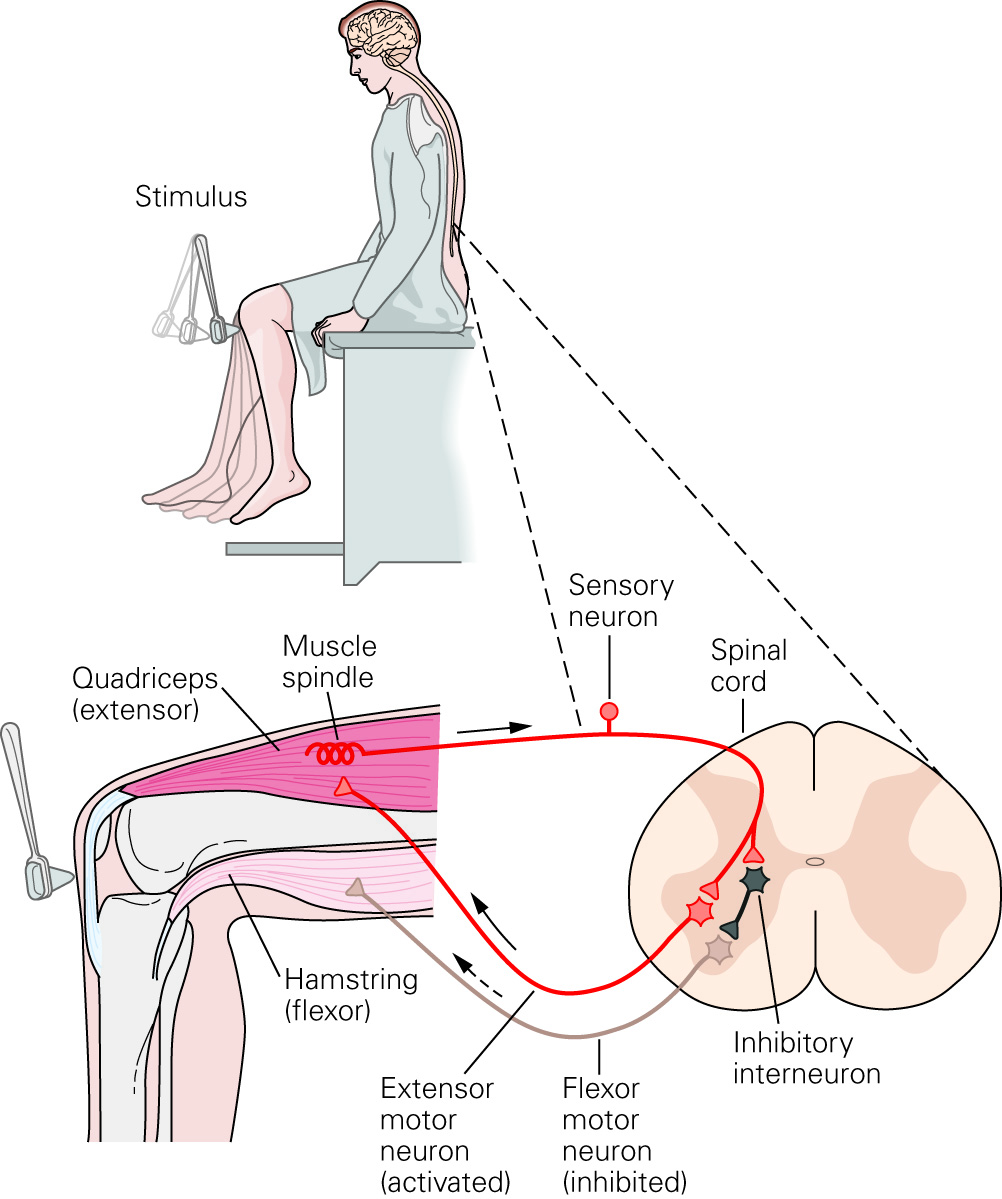
the stretching of just one muscle, the quadriceps, activates several hundred sensory neurons, each of which makes direct contact with 45 to 50 motor neurons. this pattern of connection, in which one neuron activates many target cells, is called divergence. it is especially common in the input stages of the nervous system; by distributing its signals to many target cells, a single neuron can exert wide and diverse influence. conversely, a single motor cell in the knee jerk circuit receives 200 to 450 input contacts from approximately 130 sensory cells. this pattern of connection is called convergence. it is common at the output stages of the nervous system; a target motor cell that receives information from many sensory neurons is able to integrate information from many sources. convergence also ensures that a motor neuron is activated only if a sufficient number of sensory neurons become activated together( figure followed):
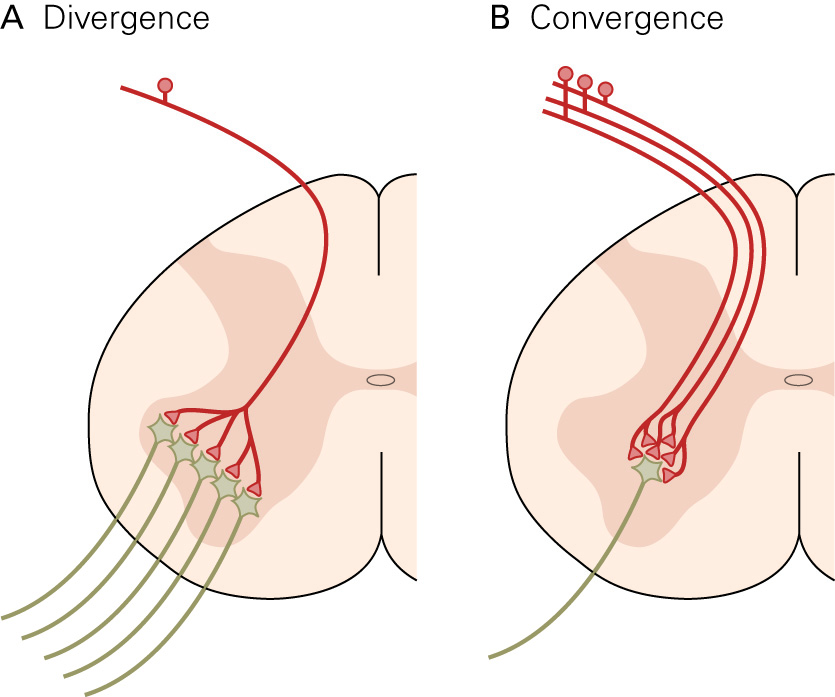
feed-forward inhibition and feedback inhibition( figure followed):
signaling is organized in the same way in all nerve cells
29
to produce a behavior, a stretch reflex for example, each participating sensory and motor nerve cell must generate four different signals in sequence, each at different size within the cell: an input signal, a trigger signal, a conducting signal, and an output signal. regardless of cell size and shape, transmitter biochemistry, or behavioral function, almost all neurons can be described by a model neuron that has four functional components that generate the four types of signals: a receptive component, a summing or integrative component, and a secretory component. this model neuron is the physiological expression of Ramon y Cajal’s principle of dynamic polarization( figure followed):
the input component produces graded local signals
31
like the receptor potential, the synaptic potential is graded; its amplitude depends on how much transmitter is released. in the same cell the synaptic potential can be either depolarizing or hyperpolarizing depending on the type of receptor molecule that is activated. synaptic potentials, like receptor potentials, spread passively and thus are local changes in potential unless the signal reaches beyond the axon’s initial segment and thus can give rise to an action potential
D. when the action potential reaches the synaptic terminal, in initiates the release of a neurotransmitter, the chemical substance that serves as the output signal. the frequency of action potentials determines exactly how much neurotransmitter is released by the cell
the trigger zone makes the decision to generate an action potential
the conductive component propagates an all-or-one action potential
35
if signals are stereotyped and reflect only the most elementary properties of the stimulus, how can they carry the rich variety of information needed for complex behavior? how is a message that carries visual information? how is a message that carries visual information about a bee distinguished from one that carries pain information about the bee’s sting, and how are these sensory signals distinguished from motor signals for voluntary movement? the answer is simple and yet is one of the most important organizational principles of the nervous system: pathways of connected neurons, not individual neurons, convey information. interconnected neurons form anatomically and functionally distinct pathways. the neural pathways activated by receptor cells in the retina that respond to light are completely distinct from the pathways activated by sensory cells in the skin that respond to touch
the output component releases neurotransmitter
35
when an action potential reaches a neuron’s terminal it stimulates the release of chemical substances from the cell. once released, the neurotransmitter is the neuron’s output signal. like the input signal, it is graded. the amount of transmitter released is determined by the number and frequency of the action potentials that reach the presynaptic terminals. after release the transmitter diffuses across the synaptic cleft and binds to receptors on the postsynaptic neuron. this binding causes the postsynaptic cell to generate a synaptic potential. whether the synaptic potential has an excitatory or inhibitory effect depends on the type of receptor in the postsynaptic cell, not on the particular chemical neurotransmitter. the same transmitter substance can have different effects at different effects at different receptors
the transformation of the neural signal from sensory to motor is illustrated by the stretch-reflex pathway
35
when a muscle is stretched, the amplitude and duration of the stimulus are reflected in the amplitude and duration of the receptor potential generated in the sensory neuron. if the receptor potential exceeds the threshold for an action potential in that cell, the graded signal is transformed at the trigger zone into an action potential, an all-or-none signal. the more the receptor potential exceeds threshold, the greater the frequency of action potentials in the axon. the duration of the input signal also determines the duration of the train of action potentials
the information encoded by the frequency and duration of firing is faithfully conveyed along the axon to its terminals, where the firing of action potentials determines the amount of transmitter released. these stages of signaling have their counterparts in the motor neuron and in the muscle( figure followed):
nerve cells differ most at the molecular level
35
as we shall learn in chapter 7, different ion channels provide neurons with various thresholds, excitability properties, and firing patterns. neurons with different ion channels can therefore encode synaptic potentials into different firing patterns and thereby convey different information
neural network stimulate the brain’s parallel processing of information
the stretch reflex illustrates how interactions between just a few types of nerve cells can constitute a functional circuit that produces a simple behavior, even though the number of neurons involved is large( the stretch reflex circuit has perhaps a few hundred sensory neurons and a hundred motor neurons). can the individual neurons implicated in a complex behavior be identified with the same precision?
in invertebrate animals, and in some lower-order vertebrates, a single cell( a so-called command cell) can initiate a complex behavioral sequence. but as far as we know no complex human behavior is initiated by a single neuron. rather, each behavior is generated by the actions of many cells. broadly speaking, as we have seen, there are three components of the neural control of behavior: sensory input, intermediate processing, and motor output. in vertebrates each component is likely to be mediated by a single group or several distinct groups of neurons
moreover, each component may have multiple neural pathways that simultaneously provide the same or similar information. the deployment of several neuronal groups or pathways to convey similar information is called parallel processing. parallel processing also occurs in a single pathway when different neurons in the pathway perform similar computations simultaneously. parallel processing makes enormous sense as an evolutionary strategy for building a more powerful brain, for it increases both the speed and reliability of function within the central nervous system
the importance of abundant, highly specific parallel connections has long been recognized by scientists attempting to construct theoretical models of the brain. the branch of computer science known as artificial intelligence originally used serial processing to simulate the brain’s cognitive processes–pattern recognition, learning, memory, and motor performance. these serial models performed many tasks rather well, including playing chess. however, they performed poorly with other computations that the brain does almost instantaneously, such as recognizing faces or comprehending speech
many theoretical nuerobiologists have turned to different types of models that include parallel processing, which they call neural networks. in these models, elements of the system process information simultaneously using both feed-forward and feedback connections. interestingly, in systems with feedback circuits it is the dynamic activity of the system that determines the outcome of computation, not inputs or initial conditions
neural network models capture well the highly recurrent architecture of most actual neural circuits and also the ability of the brain to function in the absence of specific sensory input from outside the body such as during thinking, sleep, and the generation of endogenous rhythms, something with which traditional deterministic models have difficulty. neural network models also show that analysis of individual elements of a system may not be enough to decode the action potential code. according to this neural network view, what makes the brain a remarkable information processing organ is not the complexity of its neurons but the fact that it has many elements interconnected in a variety of complex ways. neural network modeling is discussed in Appendices E and F
neural connections can be modified by experience
most learning results in behavioral changes that endure for years, but even simple reflexes can be modified briefly. the fact that behavior is learned raises an interesting question: how is behavior modified if the nervous system is wired so precisely? how can changes in the neural control of behavior occur when connections between the signaling units, the neurons, are set during early development?
several solutions for this dilemma have been proposed. the proposal that has proven most farsighted is the plasticity hypothesis, first put forward at the turn of the 20th century by Ramon y Cajal. a modern form of this hypothesis was advanced by the Polish psychologist Jerzy Konorski in 1948: …
there is now considerable evidence for functional plasticity at chemical synapses. these synapses often have a remarkable capacity for short-term physiological changes( lasting seconds to hours) that increase or decrease synaptic effectiveness. long-term changes( lasting days) can give rise to further physiological changes that lead to anatomical alterations, including pruning of preexisting synapses and even growth of new ones
as we shall see in later chapters, chemical synapses are functionally and anatomically modified through experience and learning as much as during early development. functional alterations, physiological changes, are typically short-term and result in changes in the effectiveness of existing synaptic connections. anatomical alterations are typically long-term and consist of the growth of new synaptic connections between neurons. it is this functional plasticity of neurons that endows each of us with our individuality








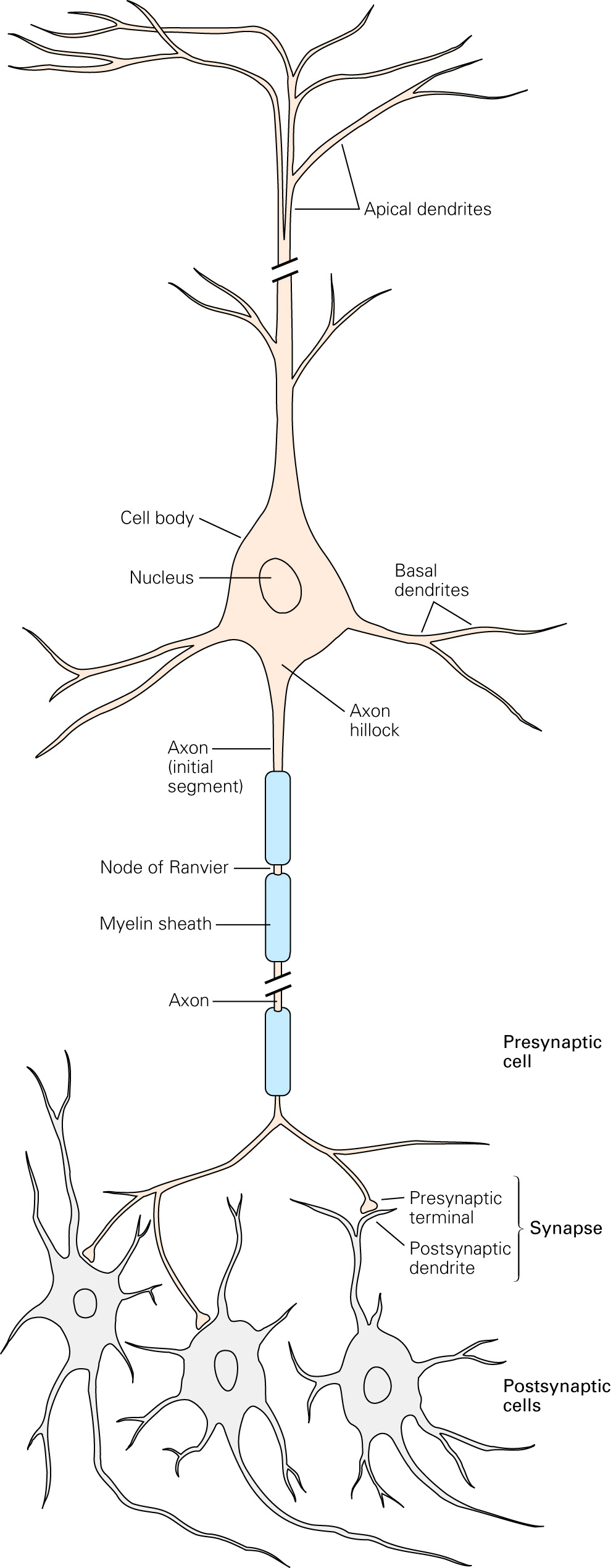
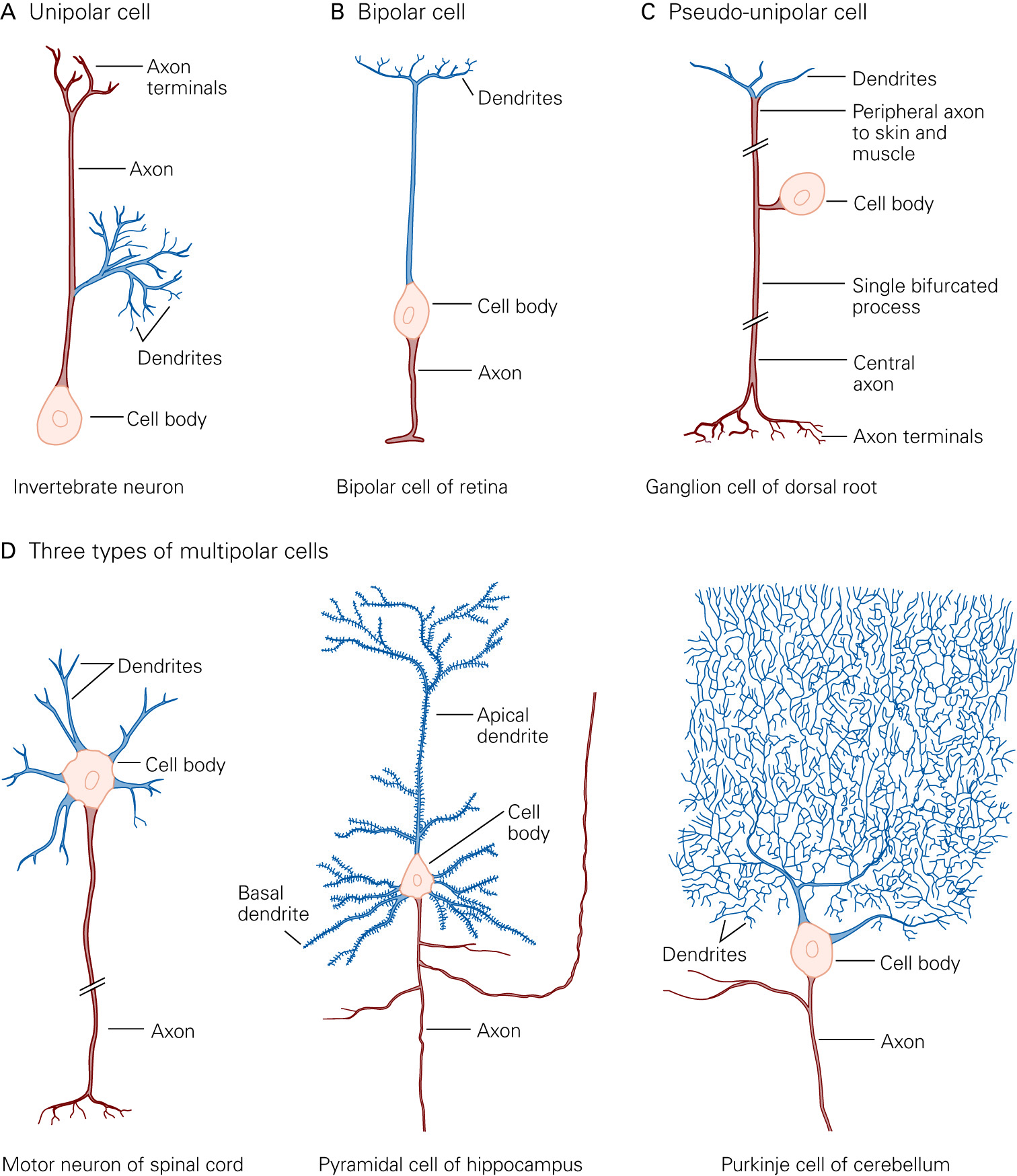
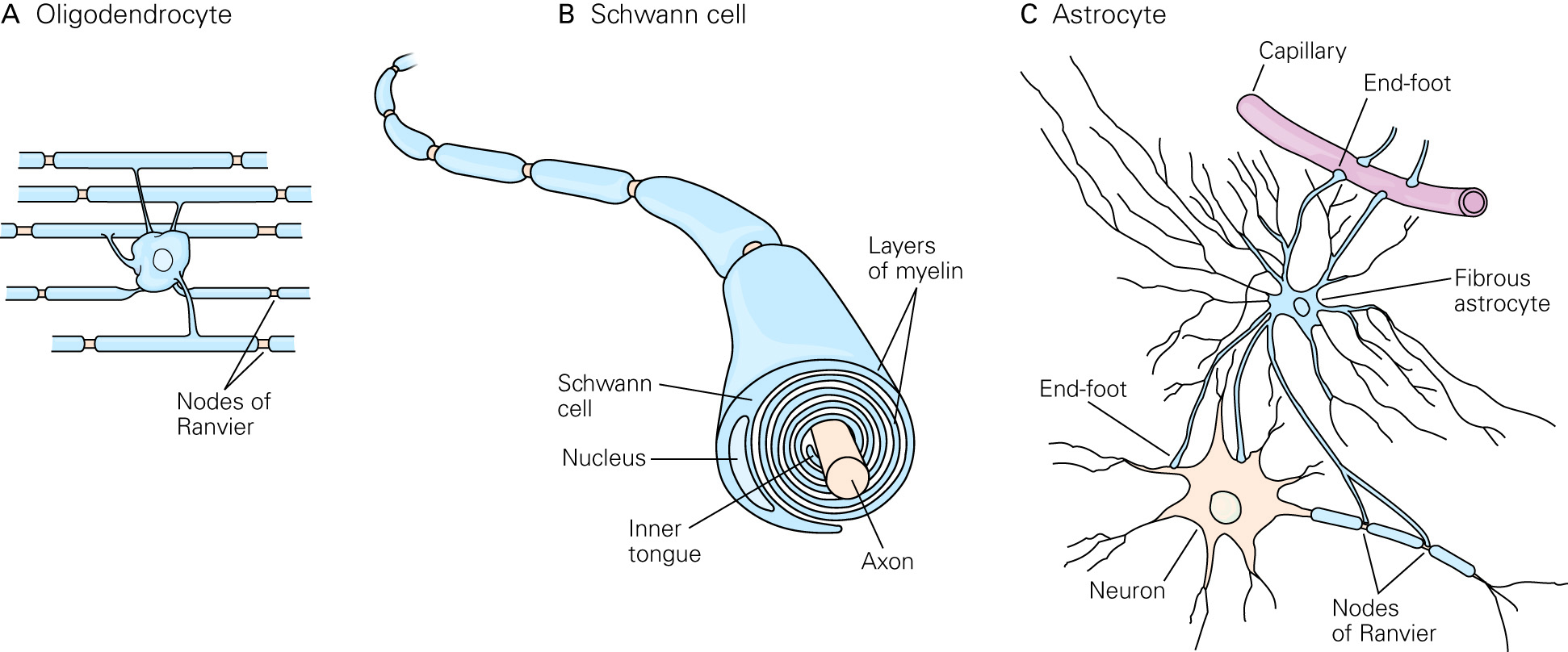

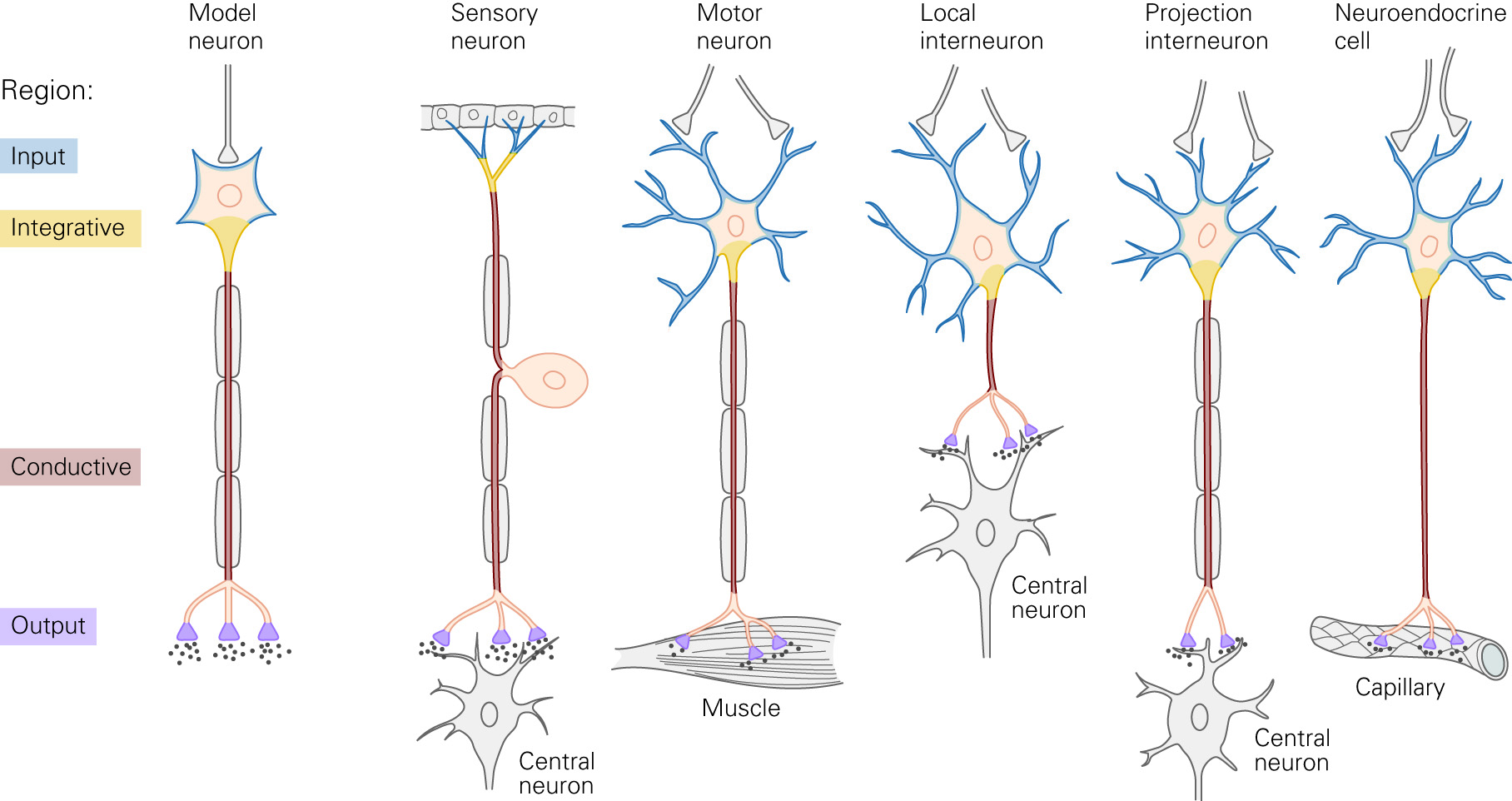
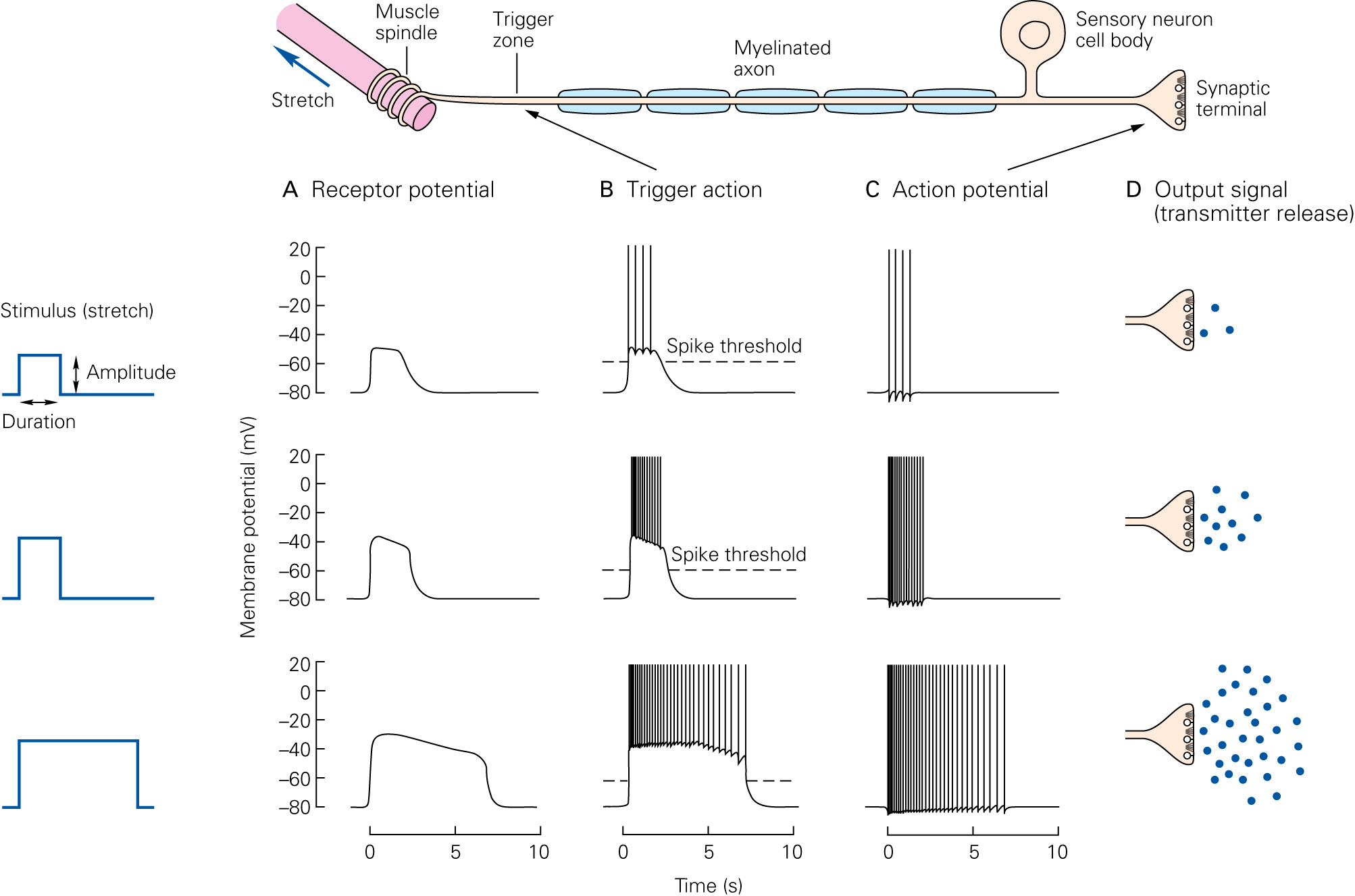
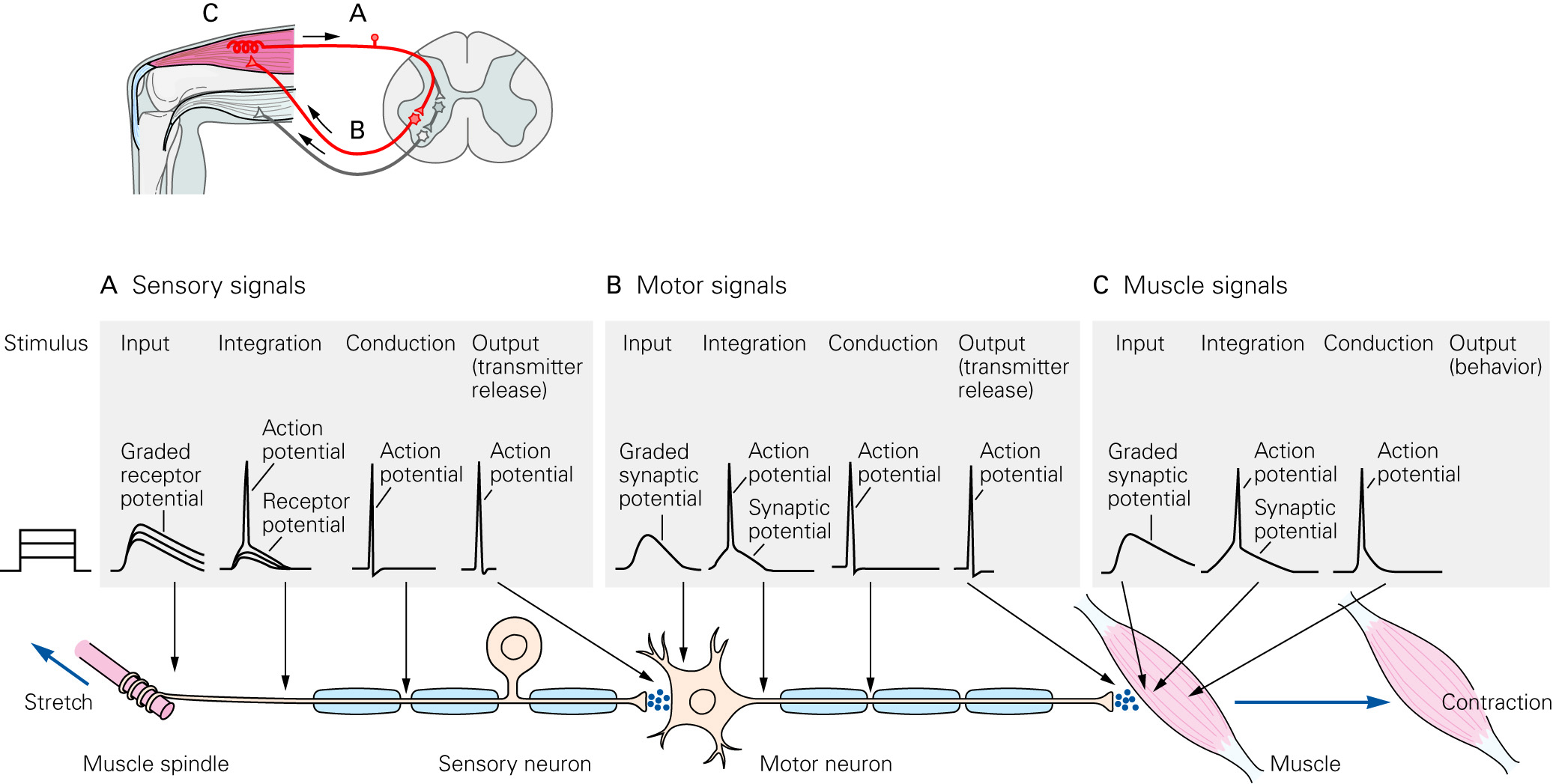














 598
598

 被折叠的 条评论
为什么被折叠?
被折叠的 条评论
为什么被折叠?








